Click on images to enlarge

infestation in a grassland (Photo: Chris Gardiner)

habit (Photo: Sheldon Navie)

shrubby habit (Photo: Chris Gardiner)
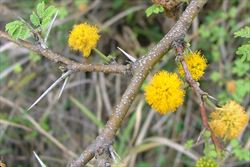
older woody stem with relatively small spines (Photo: Sheldon Navie)
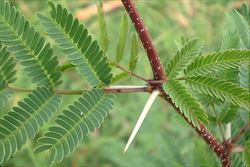
close-up of reddish-brown younger branch with prominent whitish lenticels, and a pair of relatively large whitish spines in the leaf fork (Photo: Sheldon Navie)

alternately arranged twice-compound leaves (Photo: Sheldon Navie)

close-up of leaf with small raised gland on its stalk and narrow leaflets (Photo: Sheldon Navie)

close-up of leaf undersides (Photo: Sheldon Navie)

globular flower clusters (Photo: Sheldon Navie)
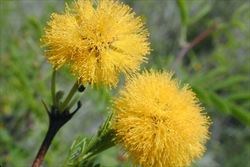
close-up of fluffy golden yellow flowers with numerous stamens (Photo: Forest and Kim Starr, USGS)
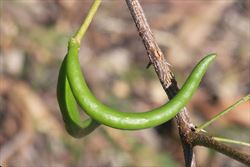
young fruit beginning to develop (Photo: Chris Gardiner)
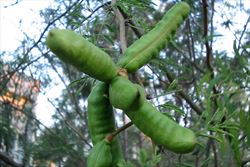
immature fruit (Photo: Sheldon Navie)

dark brown mature fruit (Photo: Sheldon Navie)

part of pod showing seeds separated by whitish pith (Photo: Forest and Kim Starr, USGS)
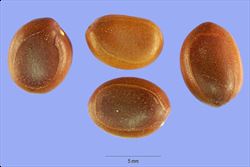
close-up of seeds (Photo: Steve Hurst at USDA PLANTS Database)
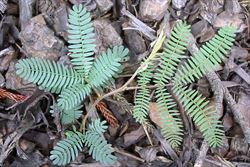
young plant (Photo: Sheldon Navie)
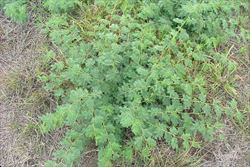
re-growth (Photo: Sheldon Navie)
Scientific Name
Vachellia farnesiana (L.) Wight & Arn.
Synonyms
Acacia farnesiana (L.) Willd.Acacia farnesiana (L.) Willd. var. farnesianaAcacia farnesiana (L.) Willd. var. lenticellata (F. Muell.) F.M. BaileyAcacia lenticellata F. Muell.Acacia pedunculata Willd.Farnesia odora Gasp.Mimosa farnesiana L.Mimosa suaveolens Salisb.Popanax farnesiana (L.) Raf.Vachellia farnesiana (L.) Wight & Arn. var. farnesiana
Family
Fabaceae: sub-family Mimosoideae (New South Wales)Leguminosae (South Australia)Mimosaceae (Queensland, the ACT, Victoria, Tasmania, Western Australia and the Northern Territory)
Common Names
briar bush, cassie, cassie flower, dead finish, downs mimosa, Ellington curse, false mesquite, farnese wattle, mimosa bush, mimosa wattle, needle bush, perfumed wattle, prickly bush, prickly mimosa bush, sponge flower, sweet acacia, thorny acacia
Origin
Possibly native to southern USA (i.e. northern Florida, Louisiana, Texas, Arizona and California), Mexico, Central America (i.e. Belize, Costa Rica, El Salvador, Guatemala, Honduras, Nicaragua and Panama), the Caribbean and northern South America (i.e. French Guiana, Guyana, Surinam, Venezuela, northern Brazil, Bolivia, Colombia and Peru). It is widely cultivated and its exact native range is obscure. Until recently this species was considered to be native to Australia, but it is now largely regarded as having been introduced to Australia prior to European settlement.
Cultivation
Has been widely cultivated in other parts of the world as an ornamental and was often grown commercially for use in perfumes. It is occasionally seen in cultivation in Australia.
Naturalised Distribution
This species is very widespread in Australia, and is particularly common in the northern parts of the country. It is common throughout most of Queensland and New South Wales, as well as large parts of the Northern Territory, the north-western and northern parts of Western Australia, and the north-eastern parts of South Australia. It is also occasionally recorded in other parts of Western Australia and South Australia and was naturalised on the Cocos Islands.
Widely naturalised in other parts of the world, including on several Pacific islands (e.g. Fiji, French Polynesia, Guam, Niue, Nauru, New Caledonia and Hawaii).
Habitat
A weed of pastures, grasslands, open woodlands, rangelands, watercourses (i.e. riparian vegetation), roadsides, waste areas and disturbed sites. It mainly grows in tropical, sub-tropical and semi-arid regions, but may occasionally also be found in arid and warmer temperate regions.
Habit
An upright (i.e. erect) or often spreading, multi-stemmed shrub usually growing 1.5 to 4 m tall, or occasionally a small tree reaching up to 7 m in height.
Distinguishing Features
-
an upright or often spreading, multi-stemmed shrub usually growing 1.5 to 4 m tall.
-
its younger branches are covered with numerous tiny whitish spots and bear pairs of whitish-coloured spines (2-45 mm long) at the base of each leaf.
-
its twice-compound leaves (5-75 mm long) usually have two to four pairs of branchlets, each bearing numerous pairs of small leaflets.
-
its bright yellow and fluffy flowers are arranged in small globular clusters (10-13 mm across) in the leaf forks.
-
its cigar-shaped pods (1.5-8.5 cm long and 8-17 mm wide) turn dark brown or black as they mature.
Stems and Leaves
The bark on older stems is smooth or finely fissured and either grey or brown in colour. Younger branches are reddish-brown and the newer shoots (i.e. branchlets) are green in colour. These rounded younger branches and branchlets are hairless (i.e. glabrous) and covered with numerous tiny whitish spots (i.e. lenticels). There are also pairs of whitish-coloured spines at the base of each leaf (i.e. stipular spines), which vary greatly is size (2-45 mm long). However, they tend to be larger on young growth and re-growth that is close to ground level.
The alternately arranged leaves are twice-compound (i.e. bipinnate) and borne on stalks (i.e. petioles) 2-20 mm long. These stalks are somewhat hairy (i.e. pubescent) and bear a small raised structure (i.e. gland) on their upper surface. The extension of the leaf stalk (i.e. rachis) is 3-55 mm long and bears one to seven (usually two to four) pairs of branchlets (i.e. pinnae). These branchlets (7-50 mm long) each have several to numerous (5-23) pairs of leaflets (i.e. pinnules). These relatively small leaflets (1.2-15 mm long and 0.5-3.5 mm wide) are usually elongated in shape (i.e. narrowly oblong) with entire margins and rounded tips (i.e. obtuse apices). They are mostly hairless (i.e. glabrous), except for some tiny hairs along their margins (i.e. they are ciliolate).
Flowers and Fruit
The flowers are arranged in small rounded (i.e. globular) clusters which are borne on hairy stalks (i.e. pubescent peduncles) 5-50 mm long originating in the leaf forks (i.e. axils). One to three, or rarely more, of these clusters (10-13 mm across) may be produced in each leaf fork. Each cluster contains numerous (40-95) bright yellow or golden yellow sweetly-scented flowers. The flowers have numerous prominent stamens, which give them a fluffy appearance. They also have five inconspicuous petals and five sepals. Flowering occurs throughout the year, but is most abundant from autumn through to spring.
The straight or slightly curved cigar-shaped pods (1.5-8.5 cm long and 8-17 mm wide) are rounded in cross section (i.e. sub-terete or terete). They are hairless (i.e. glabrous) and turn from green to dark brown or black as they mature. These fruit contain several seeds and do not split open when fully mature (i.e. they are indehiscent). The brown or olive-brown coloured seeds (6-9 mm long and 4.5-5.5 mm wide), which are flattened and somewhat oval in shape (i.e. irregularly elliptic), are separated from each other by whitish pith.
Reproduction and Dispersal
This species reproduces by seed, and also produces suckers when its aboveground parts are damaged.
Seeds are primarily dispersed when livestock and feral animals eat the fruit and pass the seeds intact.
Environmental Impact
Mimosa bush (Vachellia farnesiana) is often regarded as an environmental weed in Western Australia, Queensland and New South Wales.
Legislation
Not declared or considered noxious by any state government authorities.
Management
For information on the management of this species see the following resources:
- the Biosecurity Queensland Fact Sheet on this species, which is available online at http://www.daff.qld.gov.au
Similar Species
Mimosa bush (Vachellia farnesiana) can be confused with several other thorny bushes, including prickly acacia (Vachellia nilotica), karroo thorn (Vachellia karroo), the mesquites (Prosopis spp.), cutch tree (Senegalia chundra) and Parkinsonia (Parkinsonia aculeata). These species can be distinguished by the following differences:
- mimosa bush (Vachellia farnesiana) is a thorny plant with twice-compound (i.e. bipinnate) leaves having few (2-4) pairs of branchlets. Its fluffy bright yellow flowers are borne in small globular clusters (11-15 mm across) in the leaf forks. The large fruit are only somewhat elongated in shape (5-7 cm long and 12-15 mm wide), almost cylindrical, often slightly curved, hairless (i.e. glabrous), and turn dark brown in colour as they mature.
- prickly acacia (Vachellia nilotica) is a thorny plant with twice-compound (i.e. bipinnate) leaves having several to numerous (3-10) pairs of branchlets. Its fluffy bright yellow flowers are borne in small globular clusters (8-15 mm across) in the leaf forks. The large fruit are elongated in shape (6-25 cm long and 4-17 mm wide), somewhat flattened, softly hairy (i.. pubescent), strongly constricted between the seeds (i.e. torulose), and turn greyish-green to in colour as they mature.
- karroo thorn (Vachellia karroo) is a thorny plant with twice-compound (i.e. bipinnate) leaves having few to several (2-7) pairs of branchlets. Its fluffy bright yellow flowers are borne in small globular clusters (about 10 mm across) in the leaf forks. The large fruit are elongated in shape (6-16 cm long and 6-10 mm wide), somewhat flattened, sickle-shaped or curved, smooth and hairless (i.e. glabrous), have slight constrictions between each of the seeds, and turn dark brown in colour as they mature.
- the mesquites (Prosopis spp.) are thorny plants with twice-compound (i.e. bipinnate) leaves having few (1-5) pairs of branchlets. Its fluffy pale yellow, yellow, greenish-yellow or whitish coloured flowers are borne in elongated clusters (5-14 cm long) in the leaf forks. The large fruit are very elongated in shape (8-20 cm long and 7-15 mm wide), almost cylindrical, have slight constrictions between each of the seeds, and turn yellowish in colour as they mature.
- cutch tree (Senegalia chundra) is a thorny plant with twice-compound (i.e. bipinnate) leaves having numerous (7-24) pairs of branchlets. Its fluffy pale yellow or whitish coloured flowers are borne in elongated clusters (35-75 mm long) in the leaf forks. The large fruit are elongated in shape (5-12.5 cm long and 15-20 mm wide), flattened, softly hairy in the lower part (i.e. partly pubescent), and turn dark brown in colour as they mature.
- Parkinsonia (Parkinsonia aculeata) is a thorny plant with twice-compound (i.e. bipinnate) leaves having few (1-3) pairs of branchlets. Its bright yellow flowers (about 2 cm across) have five obvious petals and are borne in loose elongated clusters. The large fruit are somewhat elongated in shape (3-13 cm long and about 7 mm wide), almost cylindrical, strongly constricted between the seeds (i.e. torulose), hairless (i.e. glaborus), and turn light brown in colour as they mature.
Mimosa bush (Vachellia farnesiana), prickly acacia (Vachellia nilotica), the mesquites (Prosopis spp.) and Parkinsonia (Parkinsonia aculeata) are very often confused. These species are all relatively common and widespread, found in the same areas, and all have spines, compound leaves, yellow flowers and elongated seed pods. See the Queensland Department of Natural Resources and Mines fact sheet on 'Identification of Prickle Bushes' for more help with distinguishing between these species.
This fact sheet has been updated thanks to the sponsorship of Sunshine Coast Council.

